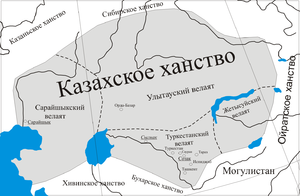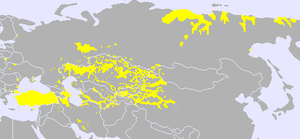خانية القزخ
Qazaq Khanate Қазақ хандығы | |||||||||
|---|---|---|---|---|---|---|---|---|---|
| 1465–1847 | |||||||||
 العلم | |||||||||
Motto: Alash! | |||||||||
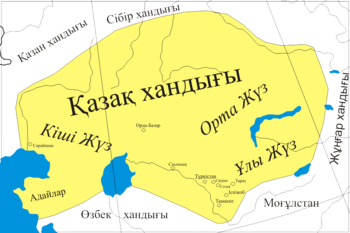 | |||||||||
| العاصمة | تركستان | ||||||||
| اللغات الشائعة | اللغة القزخية | ||||||||
| الدين | الإسلام | ||||||||
| الحكومة | Monarchy | ||||||||
| Khan | |||||||||
• 1465–1480 | Janybek Khan and Kerei Khan (first) | ||||||||
| التاريخ | |||||||||
• تأسست | 1465 | ||||||||
• انحلت | 1847 | ||||||||
| |||||||||
جزء من سلسلة عن |
||||||||||||||
|---|---|---|---|---|---|---|---|---|---|---|---|---|---|---|
| تاريخ قزخستان | ||||||||||||||
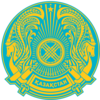 | ||||||||||||||
| قبل التاريخ | ||||||||||||||
|
||||||||||||||
| الخانيات المبكرة | ||||||||||||||
|
||||||||||||||
| العصور الوسطى | ||||||||||||||
|
||||||||||||||
| أوائل العصر الحديث | ||||||||||||||
|
||||||||||||||
| فترة ما بعد البدوية | ||||||||||||||
|
||||||||||||||
| موضوعات | ||||||||||||||
خانية القزخ (بالقزخية: [Қазақ хандығы, Qazaq handığı] Error: {{Lang}}: text has italic markup (help)؛ إنگليزية: Kazak Khanate) كانت دولة قزخية توركية خلـَفت القبيل الذهبي وتواجدت من 1456–1847، وكانت تقع تقريباً في أراضي جمهورية قزخستان الحالية.
تأسيس خانية القزخ في 1465 أشّر لبداية الدولة القزخية.[1] 2015 marks the 550th anniversary of the Kazakh statehood.[2]
. . . . . . . . . . . . . . . . . . . . . . . . . . . . . . . . . . . . . . . . . . . . . . . . . . . . . . . . . . . . . . . . . . . . . . . . . . . . . . . . . . . . . . . . . . . . . . . . . . . . . . . . . . . . . . . . . . . . . . . . . . . . . . . . . . . . . . . . . . . . . . . . . . . . . . . . . . . . . . . . . . . . . . . .
التاريخ
The Kazakh Khanate was founded in 1456-1465 by Janybek Khan and Kerey Khan, on the banks of Jetsu ("seven rivers") في الجزء الجنوبي الشرقي من أراضي جمهورية قزخستان الحالية. The founding of the Kazakh Khanate is considered the ethnogenesis of the Kazakh nation. The formation of the independent Kazakh Khanate began when several tribes under the rule of sultans Janybek and Kerey departed from the Khanate of Abu'l-Khayr Khan. The sultans led their people toward Mogolistan, eventually settling and founding an independent state. The new Khanate soon became a buffer state between the Mongolians وخانية أبو الخير. From the sixteenth through the early nineteenth century, the most powerful nomadic people were the Kazakhs and the Oirats.[3]
جانيبك خان و كري خان (1465–1480)
Although both Janybek Khan and Kerey Khan were considered the founding rulers of the Kazakh Khanate, it was Kerei Khan who initially wielded the most power. Upon the death of Kerei Khan in 1470, Janybek Khan became the sole ruler. The early years of the Kazakh Khanate were marked by struggles for control of the steppe against the Uzbek leader Muhammad Shaybani. In 1470, the Kazakhs defeated Muhammad Shaybani at the city of Turkistan, forcing the Uzbeks to retreat south to Samarkand and Bukhara.
برندق خان (1480–1511)
In 1480 Karai Khan's son Burunduk became khan. During his reign the Kazakhs were able to muster an army of 50,000 men and to repeatedly defeat the forces of Muhammad Shaybani along the Syr Darya river.
قاسم خان (1511–1518)
During the reign of Kasym Khan, the territories of the Kazakh Khanate expanded considerably. As Mirza Muhammad Haidar Dughlat later wrote in his Tarikh-i-Rashidi, "Kasym Khan now brought the Dasht-i-Kipchak under his absolute control, in a manner that no one, with the exception of Jochi, had ever done before. His army exceeded a thousand thousand". Kasym Khan instituted the first Kazakh code of laws in 1520, called "Қасым ханның қасқа жолы" (transliterated, "Qasım xannıñ qazqa jolı" — "Bright Road of Kasym Khan"). Kasym Khan also ratified his alliance with the Timurid leader Babur, particularly after the fall of the Shaybanids, and was thus praised by the Mughals and a the populace of Samarqand.
توسع خانية القزخ
During the reign of Kasym Khan, the territories of the Kazakh Khanate expanded considerably. As Mirza Muhammad Haidar Dughlat later wrote in his Tarikh-i-Rashidi, "Kasym Khan now brought the Dasht-i-Kipchak under his absolute control, in a manner that no one, with the exception of Jochi, had ever done before. His army exceeded a thousand thousand". Kasym Khan instituted the first Kazakh code of laws in 1520, called "Қасым ханның қасқа жолы" (transliterated, "Qasım xannıñ qasqa jolı" — "Bright Road of Kasym Khan"). Kasym Khan also ratified his alliance with the Timurid leader Babur, particularly after the fall of the Shaybanids, and was thus praised by the Mughals and the populace of Samarqand.
موماش خان (1518–1523)
طاهر خان (1523–1529)
Buidash Khan (1529–1533)
Togym Khan (1533–1538)
حق-ناظر خان (1537–1580)
Under Khak-Nazar Khan, also known as Haq-Nazar Khan[4] or Ak Nazar Khan,[5] the Kazakh Khanate faced competition from several directions: the Nogai Horde in the west, the Khanate of Sibir in the north, Moghulistan in the east and the Khanate of Bukhara in the south. Initially, Khak-Nazar Khan led the Kazakhs in two major battles against Khanate of Bukhara at Tashkent, then against the Chagatai leader Abdur-Rashid Khan. In 1568, the Kazakhs successfully defeated the Nogai Horde at the Emba River and reached Astrakhan, but were repelled by Russian forces. [6] [7] [8]
شيگاي خان (1580–1582)
توكل خان (1582–1598)
وسّع تـَوَكـُّل خان من سيطرة خانية القزخ على طشقند، فرغانة، أنديجان وسمرقند. In 1598, Kazakh forces approached Bukhara and besieged it for 12 days, but afterwards the Bukharan leader Pir-Muhammad and reinforcements under the command of his brother Baki-Muhammad pushed back the Kazakhs. In that battle, Tauekel Khan was wounded, and died during the retreat back to Tashkent.
. . . . . . . . . . . . . . . . . . . . . . . . . . . . . . . . . . . . . . . . . . . . . . . . . . . . . . . . . . . . . . . . . . . . . . . . . . . . . . . . . . . . . . . . . . . . . . . . . . . . . . . . . . . . . . . . . . . . . . . . . . . . . . . . . . . . . . . . . . . . . . . . . . . . . . . . . . . . . . . . . . . . . . . .
إسيم خان (1598–1628)
Esim Khan established peace with the Khanate of Bukhara and returned to them control of Samarkand. However, Bukhara was still bitter about the loss of Tashkent, and that led to additional conflicts. Starting with 1607, Khanate of Bukhara engaged in several battles and eventually obtained control of Tashkent.
سلقم-جنگير خان (1629–1680)
During Salqam-Jangir Khan's reign, a new and powerful rival for the Kazakhs appeared in the east, known as the Zunghar Khanate. The Zunghar had recently converted to Mahayana Buddhism and their Erdeni Batur believed he could reestablish the 13th-century empire of Genghis Khan. However, much had changed since the days of the Mongol Empire and the Kazakhs, like the Kirghiz and the Tatars, had almost entirely converted to Islam under the authority of Emir Timur, who also reestablished new centers of power such as سمرقند وبخارى, which had greatly influenced the founding of the Kazakh Khanate.
In 1652, the Zunghar leader Erdeni Batur attempted to eliminate the Kazakh Khanate and its inhabitants; he dispatched more than 50,000 Zunghar warriors against the Kazakh Khanate, which refused to submit to him. The early stages of their ferocious conflict took place in the Altai Mountains and later battles were fought on the vast steppes. Unable to halt the advance of the Zunghars, the Kazakh Ghazis and their leader Salqam-Jangir Khan's forces were defeated. Unfortunately in the year 1680, Salqam-Jangir Khan died in a battle, protecting his people against the Zunghars.
توكى خان (1680–1718)
Tauke Khan was elected as the leader of the Kazakh Khanate, immediately after the death of Salqam-Jangir Khan, and he led the battered Kazakh warriors across the steppes to resist the advance of the Zunghars. Unfortunately the already weakened Kazakhs were once again faced with defeat at Sayram and soon lost many major cities to the Zunghars.
Tauke Khan soon sought alliances with the Kirghiz in the south-east who were also facing a Zunghar invasion in their Issyk-Kul Lake region and even the Uyghurs of the Tarim Basin. In 1687, Zunghars besieged Hazrat-e Turkestan and were forced to retreat after the arrival led by Subhan Quli Khan.
In 1697, Tsewang Rabtan became the leader of the Zunghar Khanate, and he dispatched several of his commanders to subjugate Tauke Khan and many major wars between the Zunghars and the Kazakh Khanate continued into the following years: 1709, 1711—1712, 1714 and 1718. The Kazakh Khanate had indeed been weakened by the confrontation and nearly one-third of their population had been lost by the ensuing conflict. With Tauke Khan's death in 1718, the Kazakh Khanate splintered into three Jüz — the Great jüz, the Middle jüz and the Little jüz. Each Jüz had its own Khan from this time onward.
Tauke Khan is also known for refining the Kazakh code of laws, and reissuing it under the title "Жеті Жарғы" (transliterated, "Jeti Jarği"—"Seven Charters").
أبلاي خان (1771–1781)
Ablai Khan was a khan of the Middle jüz who managed to extend his control over the other two jüzes to include all of the Kazakhs. Before he became khan, Ablai participated in the wars against the Dzungars and proved himself a talented organizer and commander. During his actual reign, Ablai Khan did his best to keep Kazakhstan as independent as possible from the encroaching Russian Empire and the Chinese Qing Dynasty. He employed multi-vector foreign policy to protect the tribes from Chinese, Tatar and Zhongar aggressors.
كنيساري خان (1841–1847)
Kenesary was the last Kazakh Khan, and the leader of national liberation movement that resisted capture of Kazakh lands and segregation policies by Russian Empire. The grandson of Ablai Khan and largely regarded as the last ruler of Kazakh Khanate.
By the mid 19th century, Kazakhs fell into full control of Russian Empire and were banned from electing their own leader or even representative into the empire's legislative powers. All fiscal/tax collections were also taken away from local Kazakh representatives and given to Russian administrators. Kenesary Khan fought against the Russian imperial forces until his death in 1847.
In 1841, on all-Kazakh Kurultai Kenesary was elected as Khan (supreme leader) by all Kazakh representatives. The ceremony of coronation took as per all Kazakh traditions.
As a freedom fighter and popular as a leading voice against the increasingly aggressive and forceful policies of the Russian Empire, Kenesary was ruthless in his actions and unpredictable as a military strategist. By 1846, however, his resistance movement had lost momentum as some of his rich associates had defected to the Russian Empire, having been bribed and being promised of great riches. Betrayed, Kenesary Khan grew increasingly suspicious of the remaining members of the Resistance, possibly further alienating them. In 1847, the Khan of the Kazakhs met his death in Kyrgyz lands during his assault on northern Kyrgyz tribes. He was executed by Ormon Khan, the sarybagysh tribe leader who was subsequently rewarded by the Russians with a larger estate and an official administrative role, but was still widely regarded as a traitor by most nomadic tribes. Kenesary Khan's head was cut off and sent to the Russians.
During the last decade, Kenesary Khan has become increasingly regarded as a hero in Kazakh literature and media. Kenesary Khan can be seen on the shore of the river Esil in the capital of Kazakhstan, Astana.
تفكك الخانية والاحتلال الروسي
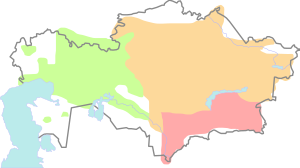
Gradual decline, disintegration and accession of Kazakh territories into Russian Empire began in mid 18th and ended in the second part of the 19th century.
By the mid 18th century, as a result of long lasting armed conflicts with Dzungars and Oirats, Kazakh Khanate starts to decline and further disintegrate into three Jüz-es, which formerly constituted Kazakh Khanate in a confederate form.
By the Russian historical political reason the Russians made fake document where written as: Battered by the warfare, seeking external military support the Khan of the Junior Jüz Abul Khair signs a protectorate agreement with Russian Empire. Preserving him as a ruler and all other powers, he pledges the allegiance to the Russian Crown. But in the original text there is no word about protectorate or seeking external power, Abul Khair Khan wrote a letter to Russian Empire asking them not to disturb relative nation bashkorts.
By the mid 19th century some tribes of Middle Jüz, started war with Russian occupiers. The process, however, was long and filled with many minor and major armed conflicts and resistance.
Russian colonial policies/strategies brought military fortresses, settlements, as well as externally imposed rules into Kazakh lands. A series of laws by the Russian Empire were introduced that abolished local indigenous government in the form of Khan rule and instituted segregative settlement policies. This resulted in numerous uprisings against colonial rule. Significant resistance movements were led by leaders such as Isatay Taymanuly (1836 - 1837), Makhambet Utemisuly (1836 - 1838) and Eset Kotibaruli (1847 - 1858).
Meanwhile, Senior Jüz sided with إمارة بخارى وخانية قوقند from south, and started opposing to the expansion of Russian Empire.
Full rule of the Russian Empire over all Kazakh lands was established in the second half of the 19th century, after southern towns of Aq-Meshit, Shymkent, Aulie-Ata and others were taken by Russian Imperial Army.
الذكرى 550
2015 marked the 550th anniversary of the establishment of Kazakh Khanate.[9] On that occasion Kazakhstan planned events dedicated to the celebration of the anniversary. Main events are planned in Astana for September 11 and in Taraz for October 9, 2015.[10] Kazakhstan's President Nursultan Nazarbayev said of the 550th anniversary celebrations, "The celebration of the Kazakh Khanate's 550th anniversary is to make our descendants understand history and promote our culture."[11]
Produced in coordination with the 550th anniversary of the Kazakh Khanate, is a 10-episode series called "Kazakh Eli", also to be a motion picture.[12]
الهامش
- ^ "Kazakh Khanate – 550th anniversary". http://e-history.kz.
{{cite web}}: External link in|website= - ^ "Kazakhstan to Celebrate 550th Kazakh Statehood Anniversary in 2015". http://astanatimes.com.
{{cite news}}: External link in|publisher= - ^ Middle East, western Asia, and northern Africa. By Ali Aldosari
- ^ http://www.britannica.com/EBchecked/topic/254780/Haqq-Nazar
- ^ A History of the Moghuls of Central Asia: The Tarikh-i-Rashidi
- ^ http://www.britannica.com/EBchecked/topic/254780/Haqq-Nazar
- ^ A History of the Moghuls of Central Asi: The Tarikh-i-Rashidi By Mirza Muhammad Haidar Dughlt, N. Elias, Sir E Denison Ross page 121
- ^ http://books.google.com.pk/books?id=1pkeWqq7pdgC&pg=PA121&dq=sultan+Abdul+rashid+khan&hl=en&sa=X&ei=poyNUMidMZKZhQen54DoCA&redir_esc=y#v=onepage&q=Ak%20nazar%20khan&f=false
- ^ "Kazakh statehood is 550 years old: Nazarbayev". TengriNews.
- ^ "Kazakh Khanate's 550th anniversary to be marked in Astana and Taraz". www.inform.kz. Retrieved 2015-09-29.
- ^ "President Nazarbayev marks Kazakh Khanate's 550th anniversary in Taraz - Global Times". www.globaltimes.cn. Retrieved 2015-11-28.
- ^ "President Nazarbayev visits Kazakhfilm studio". KazakhTV.
. . . . . . . . . . . . . . . . . . . . . . . . . . . . . . . . . . . . . . . . . . . . . . . . . . . . . . . . . . . . . . . . . . . . . . . . . . . . . . . . . . . . . . . . . . . . . . . . . . . . . . . . . . . . . . . . . . . . . . . . . . . . . . . . . . . . . . . . . . . . . . . . . . . . . . . . . . . . . . . . . . . . . . . .
انظر أيضاً
- List of Turkic dynasties and countries
- تاريخ قزخستان
- قائمة الخانات القزخ
- List of Sunni Muslim dynasties
- Nomad (2006 film)
الهامش
- Pages using infobox country with unknown parameters
- Former country articles categorised by government type
- Portal-inline template with redlinked portals
- Pages with empty portal template
- Lang and lang-xx template errors
- Articles containing إنگليزية-language text
- Pages using Lang-xx templates
- Articles with hatnote templates targeting a nonexistent page
- خانية القزخ
- دول توركية
- أسر توركية
- دول وأقاليم تأسست في 1456
- تاريخ قزخستان
- تاريخ الشعوب التوركية
- بلدان سابقة في آسيا
- انحلالات 1731
- دول توركية تاريخية

